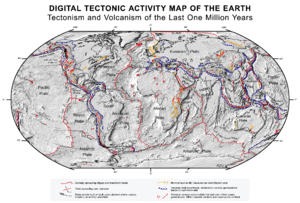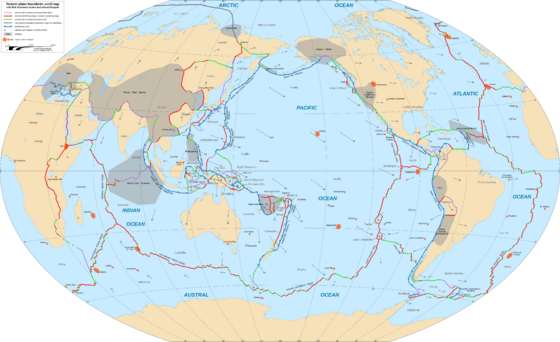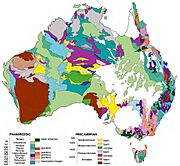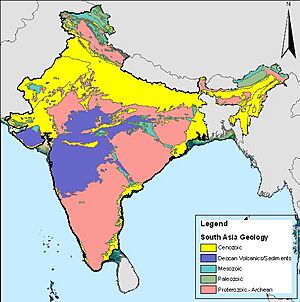List of tectonic plates facts for kids
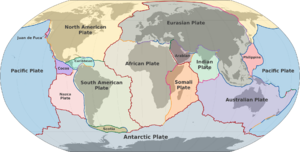
Divergent:
Our Earth's surface is not one solid piece. Instead, it's like a giant puzzle made of huge, moving pieces called tectonic plates. These plates are made of the Earth's crust and the very top part of the Earth's mantle, which together are called the lithosphere.
These plates are about 100 kilometers (60 miles) thick. They are made of two main types of material: oceanic crust (found under oceans) and continental crust (which makes up the land we live on). Oceanic crust is mostly made of heavy, dark rocks like basalt. Continental crust is lighter and made of rocks like granite.
Contents
Current Tectonic Plates
Scientists agree that there are many tectonic plates moving on Earth today. These plates have boundaries that can be mapped. Tectonic plates are often put into three groups based on their size: major plates, minor plates, and microplates.
Major Plates
These are the biggest plates. They make up most of the continents and the Pacific Ocean. For this list, a major plate is any plate larger than 20 million square kilometers.
- African Plate – 61,300,000 km2
- Antarctic Plate – 60,900,000 km2
- Eurasian Plate – 67,800,000 km2
- Indo-Australian Plate (sometimes seen as two separate plates) – 58,900,000 km2
- Australian Plate – 47,000,000 km2
- Indian Plate – 11,900,000 km2
- North American Plate – 75,900,000 km2
- Pacific Plate – 103,300,000 km2
- South American Plate – 43,600,000 km2
Minor Plates
These plates are smaller and often not shown on maps of the major plates. Most of them don't cover large land areas. For this list, a minor plate is smaller than 20 million km2 but larger than 1 million km2.
- Amurian Plate
- Arabian Plate – 5,000,000 km2
- Burma Plate – 1,100,000 km2
- Caribbean Plate – 3,300,000 km2
- Caroline Plate – 1,700,000 km2
- Cocos Plate – 2,900,000 km2
- Indian Plate – 11,900,000 km2
- Nazca Plate – 15,600,000 km2
- New Hebrides Plate – 1,100,000 km2
- Okhotsk Plate
- Philippine Sea Plate – 5,500,000 km2
- Scotia Plate – 1,600,000 km2
- Somali Plate – 16,700,000 km2
- Sunda Plate
- Yangtze Plate
Microplates
Microplates are the smallest plates, usually less than 1 million km2. They are often considered part of a larger nearby plate. Newer studies suggest that even larger plates are made up of many tiny microplates. Some scientists have identified about 1200 of these smaller pieces.
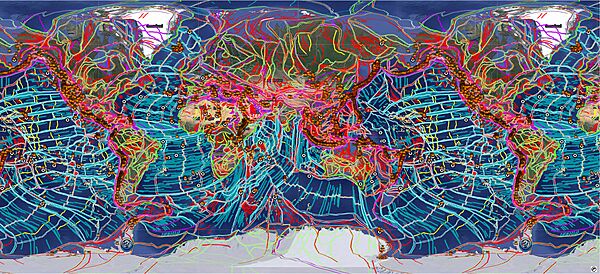
- African Plate
- Lwandle Plate
- Rovuma Plate
- Victoria Microplate
- Antarctic Plate
- East Antarctic Plate
- Shetland Plate
- West Antarctic Plate
- Australian Plate
- Capricorn Plate
- Futuna Plate
- Kermadec Plate
- Macquarie Plate
- Maoke Plate
- Niuafo'ou Plate
- Tonga Plate
- Woodlark Plate
- Caribbean Plate
- Gonâve Microplate
- North Hispaniola Microplate
- Panama Plate
- Puerto Rico-Virgin Islands Microplate
- South Jamaica Microplate
- Cocos Plate
- Rivera Plate
- Eurasian Plate
- also known as the Apulian Plate
- also known as Hellenic Plate
- Anatolian Plate
- Azores Microplate
- Banda Sea Plate
- Hreppar Microplate – A small plate in southern Iceland, between the Eurasian and North American Plates.
- Iberian Plate
- Iranian Plate
- Molucca Sea Plate
- Halmahera Plate
- Sangihe Plate
- Okinawa Plate
- Pelso Plate
- Timor Plate
- Tisza Plate
- Juan de Fuca Plate – 250,000 km2
- Explorer Plate
- Gorda Plate
- Nazca Plate
- Coiba Plate
- Malpelo Plate
- North American Plate
- Greenland Plate
- Queen Elizabeth Islands Subplate
- Pacific Plate
- Balmoral Reef Plate
- Bird's Head Plate
- Conway Reef Plate
- Easter Microplate
- Galápagos Microplate
- Juan Fernández Plate
- Manus Plate
- North Bismarck Plate
- North Galápagos Microplate
- Solomon Sea Plate
- South Bismarck Plate
- Trobriand Plate
- Philippine Sea Plate
- Mariana Plate
- also known as Philippine Microplate
- Scotia Plate
- South Sandwich Plate
- Somali Plate
- Madagascar Plate
- South American Plate
Ancient Tectonic Plates
Over Earth's long history, many tectonic plates have formed and then disappeared. They might have joined with other plates to make bigger ones, split into smaller pieces, or been pushed under other plates.
Below is a list of ancient cratons, microplates, and terranes that no longer exist as separate plates. Cratons are very old and strong parts of continents. Shields are parts of cratons that are exposed at the surface. Terranes are pieces of crust that broke off one plate and attached to another.
African Plate
- Atlantica
- Bangweulu Block (Zambia)
- Congo Craton (Angola, Cameroon, Central African Republic, DR Congo, Gabon, Sudan, and Zambia)
- Kaapvaal Craton (South Africa)
- Kalahari Craton (South Africa)
- Saharan Metacraton (Algeria)
- Sebakwe proto-Craton (Zimbabwe)
- Tanzania Craton (Tanzania)
- West African Craton (Algeria, Benin, Burkina Faso, Côte d'Ivoire, Gambia, Ghana, Guinea, Guinea Bissau, Liberia, Mali, Mauritania, Morocco, Nigeria, Senegal, Sierra Leone, and Togo)
- Zaire Craton (Congo)
- Zimbabwe Craton (Zimbabwe)
Antarctic Plate
- Bellingshausen Plate
- Charcot Plate
- also known as East Antarctic Craton
- Phoenix Plate
Eurasian Plate
- Armorica (France, Germany, Spain and Portugal)
- Avalonia (Canada, Great Britain, and United States)
- Baltic Plate
- Belomorian Craton
- Central Iberian Plate
- Cimmerian Plate (Anatolia, Iran, Afghanistan, Tibet, Indochina and Malaya)
- East China Craton
- East European Craton
- also known as Fennoscandian Shield
- Junggar Plate and Eastern Kazakhstan
- Hunic plate
- Karelian Craton
- Kazakhstania and the Junngar Basin in China
- Kola Craton
- Lhasa terrane
- Massif Central
- Moldanubian Plate
- Moravo Silesian Plate
- Midlands Microcraton
- North Atlantic Craton
- North China Craton
- Ossa-Morena Plate
- Piemont-Liguria Plate
- Proto-Alps Terrane
- Rhenohercynian Plate
- Sarmatian Craton
- Saxothuringian Plate
- Siberian Craton
- South Portuguese Plate
- Tarim Craton
- Teplá-Barrandian Terrane
- Ukrainian Shield
- Valais Plate
- Volgo-Uralian Craton
- Yakutai Craton
- Yangtze Craton
Indo-Australian Plate
- Altjawarra Craton (Australia)
- Bhandara Craton, (India)
- Bundelkhand Craton, (India)
- Dharwar Craton
- Central Craton (Australia)
- Curnamona Craton (Australia)
- Gawler Craton
- Indian Craton
- Narooma Terrane
- Pilbara Craton
- Singhbhum Craton (India)
- Yilgarn Craton
- also known as Western Australian Shield
- Zealandia. See Moa Plate and Lord Howe Rise
North American Plate
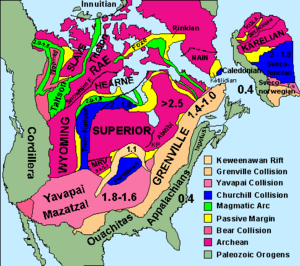
- Avalonia (Canada, Great Britain, and United States)
- Carolina Plate
- Churchill Craton (Canada)
- Farallon Plate (split into the Cocos, Explorer, Juan de Fuca, Gorda, Nazca, and Rivera Plates)
- Florida Plate (United States)
- Hearne Craton (Canada)
- Laurentian Craton (Canada and United States)
- Insular Plate
- Intermontane Plate
- Izanagi Plate
- Mexican Plate
- Nain Province (Canada)
- Newfoundland Plate
- North Atlantic Craton
- Nova Scotia Plate
- Rae Craton (Canada)
- Sask Craton (Canada)
- Sclavia Craton (Canada)
- Slave Craton (Canada)
- Superior Craton (Canada)
- Wyoming Craton (United States)
South American Plate
- Amazonian Craton (Brazil)
- Guiana Shield (Brazil, Colombia, French Guiana, Guyana, Suriname and Venezuela)
- Río de la Plata Craton (Argentina and Uruguay)
- São Francisco Craton (Brazil)
- Arequipa–Antofalla Craton (Argentina, Bolivia, Chile and Peru)
See also
 In Spanish: Anexo:Placas tectónicas para niños
In Spanish: Anexo:Placas tectónicas para niños
- Asthenosphere
- Continent
- Craton
- Platform
- Shield
- Earth's crust
- Earth's mantle
- Lower mantle
- Upper mantle
- Geochemistry
- Sial
- Sima
- Hydrosphere
- Lithosphere
- Ocean
- Plate tectonics
- List of tectonic plate interactions – Types of plate boundaries
- Supercontinent
- Terrane


